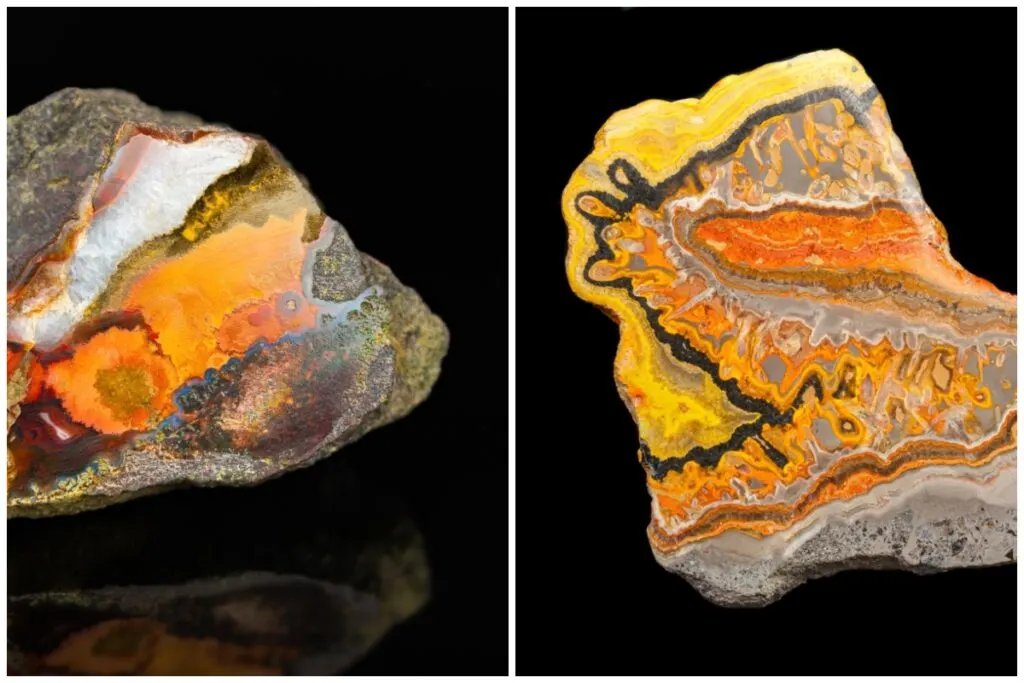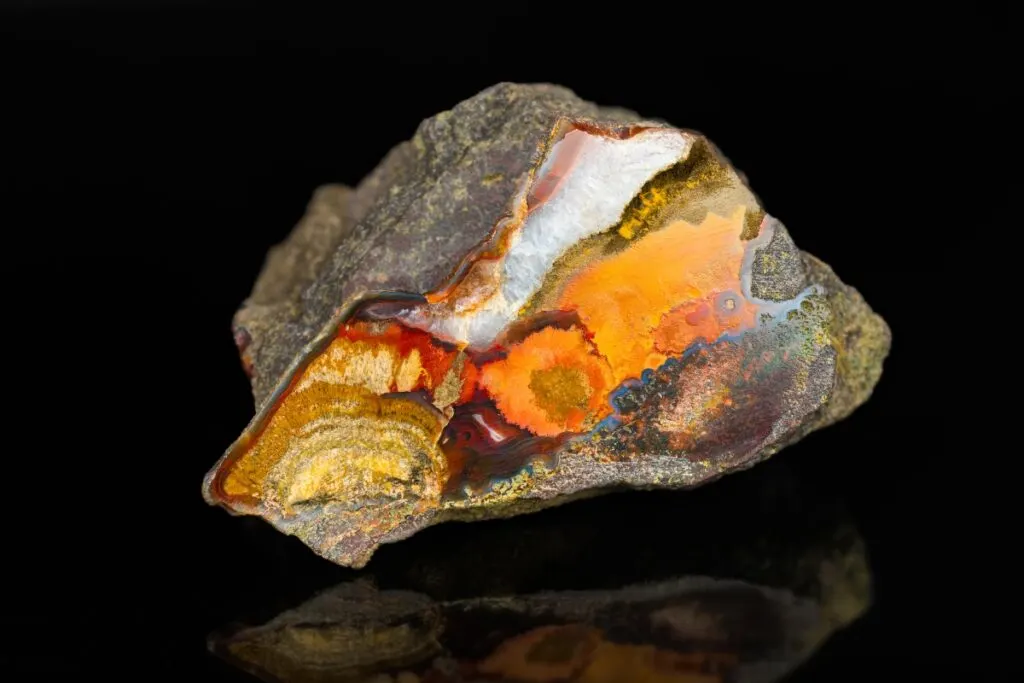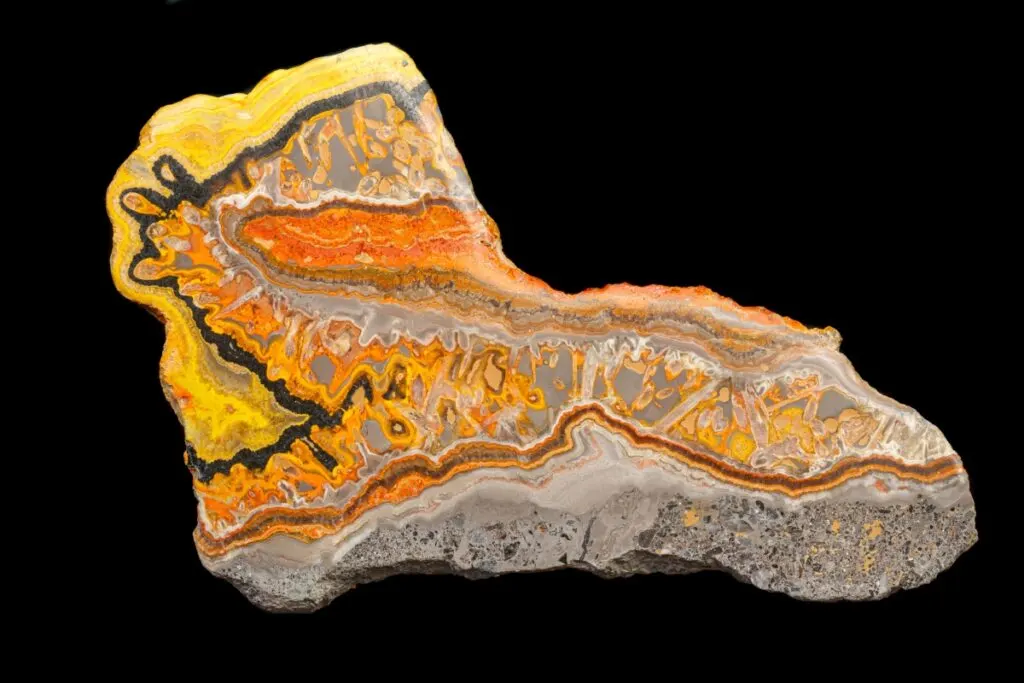As an Amazon Associate, I earn from qualifying purchases with no additional costs for you.
Jasper and agate are natural chemical compounds that are debated in science. Scientists cannot conclude whether agate and jasper can be considered the same mineral chalcedony or not. There are scientific arguments in support of both opinions, which we will present in this article.
Today, the prevailing opinion in the scientific community is that agate and jasper are both varieties of chalcedony. Jasper is an opaque variety of chalcedony, and agate is a semitransparent to a semitranslucent variety of chalcedony that is typically banded or striped in appearance.
According to other scientists, agate and jasper are not a type of chalcedony but only contain chalcedony in their composition. In this post, we will look at different views on the issue of agate and jasper, as well as consider various arguments in support of one or another opinion.

If you want to check out the best rock and mineral identification books, you can find them here (Amazon link).
Are Agate and Jasper the Same
The most common opinion among scholars is that аgate and jasper are not the same minerals but are both varieties of chalcedony, a form of microcrystalline quartz.
A less common opinion is that agate and jasper have a polymineral chemical composition, so it is incorrect to refer them to as chalcedony.
To answer this question, we must look at the definitions of agate and jasper, their properties, and their genesis.
What is Agate

Recent mineralogical and geochemical investigations during the last decades significantly increased our knowledge about the mineralogy and genesis of agates.
According to these recent studies, agates can be regarded as semitransparent to semi-translucent banded chalcedony, which is intergrown or intercalated with other silica phases.
However, some agates do not have obvious bands. These are often translucent agates with plume-shaped, dendritic, or mossy inclusions.
Moreover, agates often contain considerable amounts of mineral inclusions and water. These impurities may form spectacular internal structures or may be responsible for the different coloration of agates.
Although agate is considered a mineral, it is often found as a mineral aggregate. When agate forms, it often occurs as a series of concentric bands or layers of different colors and textures, which result from the gradual deposition of mineral materials over time.
Numerous mineralogical investigations have shown that most agates have more than one silica phase and more than one mineral. Chalcedony is the common and dominant form of silica in agates, but except it, there are opal and macro-crystalline forms of quarts.
In general, it was found that the visible bands are caused by variations in the type of silica phases, their crystal size and habitus, and the porosity and distribution of mineral inclusions (e.g., iron oxides/hydroxides) in the SiO2 matrix.
Conclusion: Essentially, banded agate is composed of several silica minerals, the dominant among which is chalcedony. Because of this, agate is considered a type of chalcedony, although other forms of silica are also present in agate.
BTW: Do you want to know more about rock and mineral identification? The books listed below are the best ones you can find on the internet (Amazon links):
- Smithsonian Handbooks: Rocks & Minerals
- Gemstone & Crystal Properties (Quick Study Home)
- Ultimate Explorer Field Guide: Rocks and Minerals (National Geographic Kids)
Genesis of Agate
Agates are commonly found in areas where there has been volcanic activity. This is because water rich in dissolved silica flows through fractures and cavities in igneous rocks.
If the solution is highly concentrated with silica, a silica gel can form on the walls of these cavities. Over time, additional gel layers are deposited, forming younger bands of microcrystalline quartz on the walls of the cavity.
Suppose the mineral composition of the silica-rich water changes, impurities other than silicon and oxygen can be incorporated into the gel and the microcrystalline quartz.
These impurities can alter the color of the quartz, creating color banding. In addition, the crystallization of foreign materials can form plumes, dendrites, or mossy structures in translucent agate.
While agates usually form in igneous rocks like basalt, rhyolite, and andesite, they can also form in sedimentary rocks like limestone. As you can see, these types of genesis provide the striping of agate.
TIP: Agate is one of the most widespread semi-precious stones. Fake agates have flooded online shops these days. Check out the differences between real and fake agate in the article below:
Real vs. Fake Agate: You Should Know These 7 Differences
What is Jasper

The term ” jasper” has several definitions, depending on the scientific field and context. Still, the most commonly accepted definition today is this – jasper is an opaque mineral aggregate of microgranular quartz and/or cryptocrystalline chalcedony (to 80%) containing many of impurities that determine its opacity and color.
Because jasper consists of several SiO2 minerals and contains many inclusions, scientists debate whether jasper is a mineral or a rock.
However, here we need to clarify one important thing – the mineralogical term “jasper” and the trade name “jasper” differ.
The fact is that there are rocks that are identical in appearance and physical properties to jaspers but have a slightly different chemical composition. From a mineralogical point of view, this is distinguished as follows:
1. Jaspers – dominantly quartz and chalcedony-quartz in composition (over 70%), represented by altered (metamorphosed) massive microgranular rocks with a beautiful color – they can be effortlessly polished;
2. Jasperоids – rocks with a dominant chalcedony and quartz-chalcedony composition, which are considered volcanogenic-sedimentary rocks that have undergone strong alteration, poorly altered effusive containing SiO2 and chert rocks originating from the impact of solutions on the contact of serpentinites and volcanоgenic formations;
3. Jasper-like rocks with a significant feldspar and quartz-feldspar composition and a few chalcedonies (less than 70%) – sedimentary and sedimentary-volcanоgenic аbiomorphic and biomorphic rocks built by SiO2 and remains of silica organisms, for example, lydites (with a dominant chalcedony composition), phtanites (of dominantly quartz composition and with clay and graphite impurities) and tuffites.
However, scientists have not come to a final agreement on this matter. Some researchers distinguish these three names, while others only distinguish between jasper and jasperoid. Still, others only recognize “jasper” for all these materials.
Regarding the trade term “jasper”, it is much simpler. According to commercial interpretation, jasper includes actual jasper, jasperoids, and jasper-like rocks.
All of them are characterized by common properties such as vibrant coloration, aesthetically appealing textural patterns, high hardness (no less than six on the Mohs scale), micro-cryptocrystalline structure, density, opacity, and the ability to be worked and polished to a mirror finish. Chemical composition nuances are not taken into consideration.
Suppose we discard all the nuances of chemical composition and simplify the definition of jasper as much as possible. In that case, it will be as follows: Jasper is an opaque variety of chalcedony.
Opaque means that neither light nor images pass through. Although it will not be completely correct, it is as simple and clear as possible.
BTW: If you are looking for the best UV light for rockhounding, find out my picks below (Amazon links):
- BEST OPTION: Convoy 8+ 365nm UV LED Flashlight with Patented Glass Filter
- BUDGET OPTION: Karrong Rechargeable 1200 Lumen 395nm UV Flashlight
- OPTION FOR INDOOR USAGE: Prime Upgraded Big Chip 396nm UV
Genesis of Jasper
The genesis of jasper is also an important issue. The way jasper is formed explains many inclusions and the unique appearance that distinguishes it from other types of chalcedony, including agate.
The most common theory of the genesis of jasper is the one that says that jasper is rocks or mineral formations, which are to be considered mainly among the metasomatic products as a result of metasomatism and recrystallization of the primary sedimentary-volcanic, effusive, or intrusive rocks during the processes of metamorphism”.
The theory of sedimentary jasper formation is also widespread. While agate usually forms in the cavities of igneous rocks or limestone, jasper often forms when finely dispersed materials are cemented by silica.
This often occurs in soft sedimentary rocks when silica precipitates and cements them into a solid mass. These incorporated particles give jasper its color and opacity.
Jasper is also known to form when volcanic ash or fine pyroclastic material is cemented into a solid material from precipitated silica that falls out of solution.
The cementation process is sometimes so aggressive that the sediment, ash, or volcanic particles dissolve or recrystallize into microcrystalline quartz.
TIP: If you want to know a step-by-step guide on how to identify jasper, check out the article below:
Identifying Real Jasper Mineral (Step-by-Step Guide)
Is Jasper in the Agate Family
Let’s take the view that jasper is an opaque type of chalcedony. We also accept the statement that agate is a striped type of chalcedony. Based on this, jasper is a member of the agate family.
But if we take into account the fact that agate and jasper are polymineral formations with different contents of certain minerals, we can argue that they are different mineral formations that do not belong to the same family. At the moment, this issue is still controversial among scientists.
What Is the Difference Between Jasper and Agate
Let us assume that agate and jasper belong to the same mineral, chalcedony. Based on this, all physical and chemical properties of jasper and agate will be the same. So how can we separate these two species?
The answer is simple – by appearance. Although they have some similarities in appearance, a few key differences will help you distinguish them. The first is transparency. Remember, jasper is completely opaque, while agate is translucent. The second is a characteristic pattern.
- The first significant difference between jasper and agate is their transparency. Jasper is completely opaque, while agate is translucent. However, it can be difficult to determine the boundary between translucent and opaque. In addition, some specimens can have translucent zones and opaque zones. What are they called? Some people have solved this problem by using the term “jaspagate” or “jasper-agate” when a specimen contains zones of both jasper and agate.
- Secondly, jasper and agate are famous for their characteristic appearance. Agate is known for its bands. Its stripes create a wide variety of patterns. The most common varieties are those where the stripes are arranged in concentric rings or parallel straight lines. We already know that this is the result of genesis.
But not all types of agates have stripes. For example, mossy agate has no striations; instead, it is known for tree-like patterns on the surface, which are formed by mineral dendrites. The so-called grape agate is also known for its characteristic shape reminiscent of grape bunches.
Jasper will be more difficult, as jasper can also be striped with various fancy patterns. However, as a rule, these patterns are somewhat different from that characteristic of agate. Together with opacity, this creates an appearance that is not typical for agates.
Conclusion
The terms jasper and agate have been known to people since ancient times. Of course, at that time, no one knew the nuances of their chemical composition, and their appearance distinguished agate and jasper.
Later, scientists discovered these minerals are based on a microcrystalline type of quartz called chalcedony. That is why both agate and jasper are considered to be varieties of chalcedony.
However, with the development of technology, scientists have gained technical capabilities that allow them to reveal the details of the chemical composition of these natural compounds.
As a result, it became known that agate and jasper are not mono-mineral formations but contain several minerals. Because of this, scientists are debating whether agate and jasper can be classified as chalcedony or not.
Today, the prevailing opinion in the scientific community is that agate and jasper are subspecies of the mineral chalcedony. The key differences are in their different genesis, transparency, and characteristic appearance.
Sources:
- O. Geleta, W. Nesterovsky, 2020 – Jasper and its decorative varieties
- Barsanov, Yakovleva – Mineralogy of jasper of the USSR, 1978
- Jens Götze, Robert Möckel and Yuanming Pan, 2020 – Mineralogy, Geochemistry and Genesis of Agate
- Ruslan I. Kostow, 2010 – Review on the mineralogical systematics of jasper and related rocks
TIP: The most common situation all rock hunters and mineral collectors deal with is at-home mineral identification. Check out the ultimate guide in the article below:
Identifying Minerals and Rocks at Home (Step-by-Step Guide)
